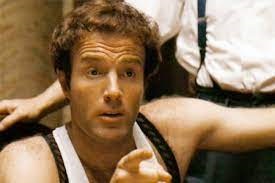|
|
|
|
|
|
So Long, Sonny
 Whenever I learn of an actor passing who had a notable death scene, I always think back to that film moment. So it was with James Caan, who recently died at the age of 82. While Caan played many roles over a 60-year career, for me he will always be Santino “Sonny” Corleone in The Godfather. Boy does Sony goes out in a blaze of glory, if one defines glory by how many times a man was shot. I wrote about the scene years ago and revisited it earlier this year with The Godfather 50th Anniversary re-release. Even in a film filled with violent sequences, Sonny’s vicious death stands apart, and Caan is a major reason why it does. The filmmakers reportedly fitted Caan with over 140 exploding squibs and fake blood pellets, so he had to get it right in one take, and he delivered. Caan imbued Sonny with so much rage and fury. He just kept coming, kept charging. Director Francis Ford Coppola reportedly claimed that the brutality and force needed to kill Sonny was the only way audiences would accept that he was truly dead. In so many ways, The Godfather broadened and deepened what a gangster movie, and gangster characters could be. Vito Corleone (Marlon Brando) was more thoughtful and measured than what audiences had seen, while Michael Corleone (Al Pacino) was more calculating and ruthless. Both men chose their words and their actions very carefully. Both played the long game. Not the hot-tempered Sonny, who acted before he thought. The way Caan played him, Sonny would have fit right in on a James Cagney gangster film. Like Cagney in The Public Enemy, Sonny was a powder keg that could go off at any time. Like Edward G. Robinson in Little Caesar, he was full of bravado and violence. He strutted like he owned the world. Caan’s Sonny was the connective tissue between the old and the new gangster films. Caan also added to what was in the script, which made many of his scenes pop. Sonny was always supposed to tease Michael about not wanting to be part of the family business, but Caan made it hilarious. He famously ad-libbed the Bada Bing!" that made the scene so memorable (and later became the name of the strip club in “The Sopranos”). Caan claimed he played Sonny with Don Rickles in mind and you can see that here in his needling of Michael. Later when Sonny goes after his abusive brother-in-law Carlo, Caan added throwing the broom handle right away, giving the scene the quick burst to pave the way for the beatdown. Even with one obviously faked punch, it’s still such a raw, feral scene, thanks largely to Caan’s physicality. When Sonny finishes with “If you touch my sister again, I’ll kill ya!” Caan makes him sound exhausted as much as angry. Underneath the bluster and the anger, Caan gave Sonny something more. During the opening wedding scenes, the married Sonny takes a bridesmaid to a side room for a quickie. Has he done that sort of thing many times? Probably. Does his father know about it? The answer comes when Don Corleone tells Johnny Fontane that “A man that doesn’t spend time with his family can "never be a real man.". The Don glances at Sonny and we see how Caan plays it so chastened. Sonny knew his father doesn’t approve of his lifestyle, and that’s all conveyed through Caan’s subtle touches. He paved the way for Sonny’s upbraiding by the Don after talking at an important meeting when he should have been listening. As his father tells him “Never tell anyone outside the Family what you are thinking again!” Caan looks like a little kid with a bad report card. Sonny wants to do right by his father and his family, but he doesn’t know how. Or if he does know deep down, his emotions and needs crowd out any understanding. Caan fleshed out Sonny with a desperation that played against his external toughness. Long after Sonny’s death, his father says “Santino would have been a bad Don.” Did Sonny always know his father felt that way about him, even on an unconscious level? Caan’s performance suggests that he might have. In all his best parts, such as Brian Piccolo in “Brian’s Song,” the title role in The Gambler, Jonathan E. in Rollerball, the title role again in Thief, or Paul Sheldon in Misery, Caan projects a struggle against cruel forces that his character may not completely comprehend. That inner doubt and frustration underneath the good looks and the macho attitude made Caan so compelling and fun to watch. Sonny’s death comes roughly 2/3 into The Godfather, and we miss him afterwards. Thankfully The Godfather, Part II brings Sonny back for a closing flashback scene. After some dark scenes prior, Sonny briefly brings some much-needed warmth, but that quickly dissipates once he learns that Michael will fight in World War II. Sonny loves his brother and worries about him, but once again his emotions can only come out through rage and violence. Coppola wisely injects some humor through Sonny’s kids (“Mommy, Daddy’s fighting again!”), but that doesn’t diminish how sad the scene becomes. Caan added small gestures, such as pushing away Fredo’s hand, that illustrate how anger remains Sonny’s constant companion and destructive flaw. 50 years later Sonny remains such a vivid, funny, dangerous and, finally, tragic character. Mario Puzo created Sonny in the novel, and Coppola refined him for the film. In the end though, it was Caan who made Sonny come alive and will keep him alive for as long as we love The Godfather. No toll booth massacre can kill that legacy. Adam Spector July 23, 2022 Contact us: |
|
